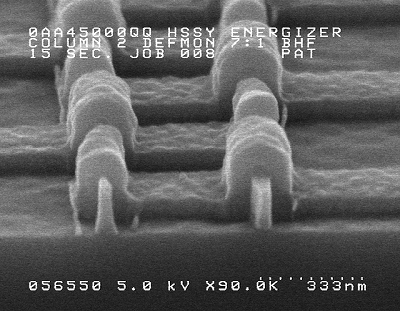Na Intel en AMD heeft nu ook IBM een nieuw type transistor onthuld waarmee processors weer een jaar of tien vooruit kunnen. C|Net schrijft dat deze Double Gate transistor uitermate geschikt is om het stroomverbruik van een chip te verlagen. Doordat de drie basiselementen van de schakeling (source, gate en drain) verbonden zijn met de ondergrond (silicium of SOI) is veel minder energie nodig dan bij een normale tranistor, waarbij de gate bovenop de andere twee elementen ligt. Geen overbodige luxe, aangezien chips met tientallen miljoenen van deze schakelaars ondanks hun geringe afmetingen gevaarlijk heet worden. IBM ziet dit soort nieuwe technieken steeds meer een kritieke steunpilaar van de organisatie worden. Dit blijkt onder andere uit de officieuze wedstijd die met HP gevoerd wordt om de eerste commerciëel toepasbare nano-technologie. Verandering kost echter tijd; hoewel er al samples zijn zullen pas in 2006 de eerste chips verschijnen met Double Gate transistors aan boord:
Transistors generally consist of three basic elements: a source, a gate and a drain. When the gate is charged, current passes from the source to the drain, and the completed circuit goes from a "0" state to a "1" state. The gate sits atop and at an equal distance from the source and drain--sort of like the top stone of a ziggurat. The source and drain, meanwhile, sit on top of silicon and--in IBM's case--on top of a layer called Silicon on Insulator (SOI).
In Double Gate transistors, the gate, rather than merely sitting on top of the source and drain, wraps around the source-drain connection like a clamp. The whole structure then lays flat on the SOI layer. By shifting the ziggurat from a standing pose to its side, all three elements touch the SOI layer, further insulating the chip.
SOI is one of the crucial elements of the new design, Davari said. A form of SOI is also critical to Intel's upcoming "Terahertz" transistor, which Davari finds ironic because Intel has criticized it for years.
Wie meer wil weten kan ook nog doorklikken naar IBM. Thanks voor de link Verwijderd.


/i/1297430422.png?f=fpa)